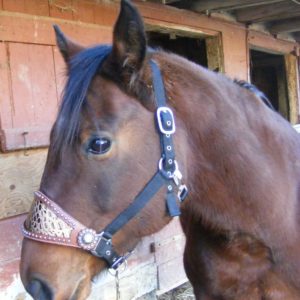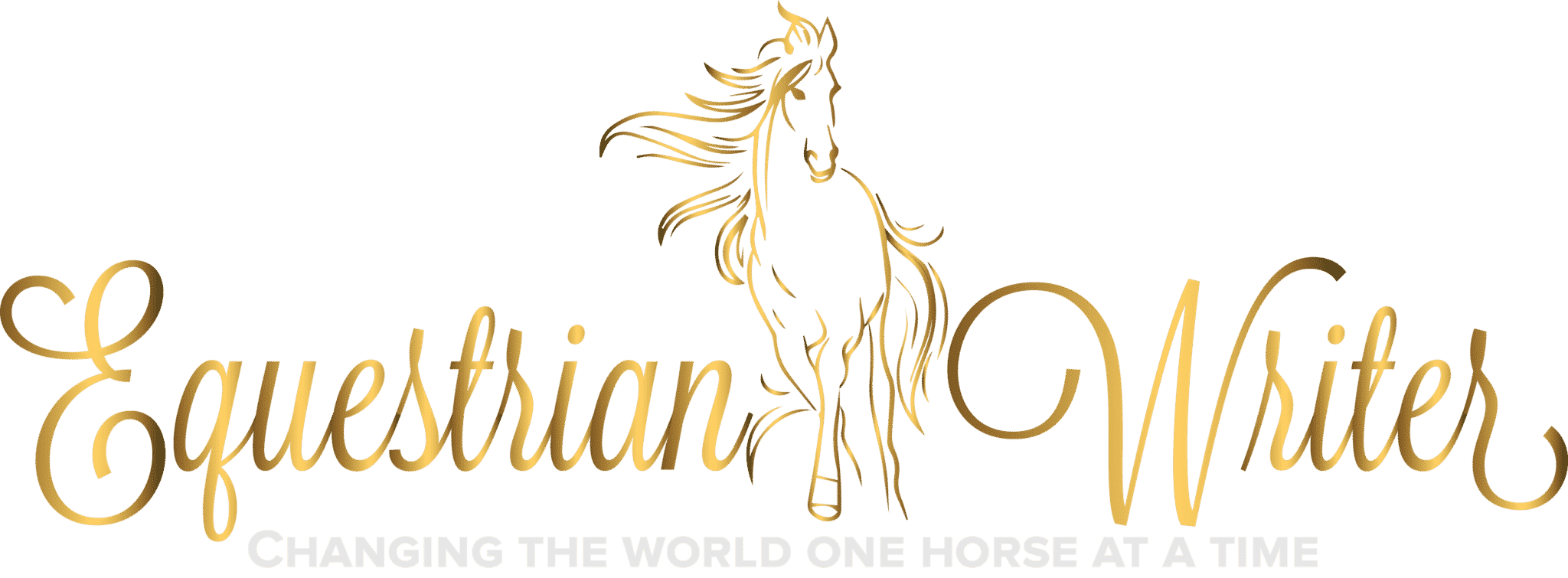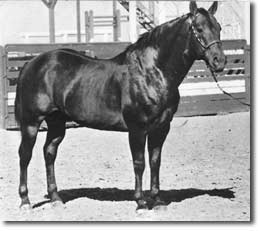
Over the years, researching quarter horse pedigrees has become a bit of a hobby, so I decided to start compiling all that research to share with all of you lovely folks. Foundation quarter horse lines are of particular interest to me seeing as my mare, Moose, is very foundation bred. So, what better place to start then good old Speedy?
The Birth of the Driftwood Dynasty
According to the AQHA Hall of Fame and Western Horseman Legends Book Volume 2, the bay stallion known to history as Driftwood (aka “Speedy”) first rose to prominence as a roper.
Speedy was born in 1932 in Silverton, Texas. He was sired by Miller Boy and out of a Lock’s Rondo-bred mare. Speedy quickly became a winner at match races.
 In 1941, when he was 9 years old, Speedy was sold to Asbury Schell of Tempe, Arizona. This was the beginning of Speedy’s roping career as Asbury’s calf and team roping horse. Speedy quickly became a fixture at all the big rodeos across the country and was ridden by some of the top timed-event hands in the business.
In 1941, when he was 9 years old, Speedy was sold to Asbury Schell of Tempe, Arizona. This was the beginning of Speedy’s roping career as Asbury’s calf and team roping horse. Speedy quickly became a fixture at all the big rodeos across the country and was ridden by some of the top timed-event hands in the business.
This was back in the day when a horse was still expected to be able to do it all, so Speedy competed in just about every timed event there was – calf roping, team tying, steer roping and bulldogging – and pulled checks in every one of them. He was famous for being able to win every event then turn around and win the stock saddle cow horse race down the length of the arena. He probably would have run barrels and poles too, but those weren’t actually a thing until after 1948.
Schell was the first to call the horse Speedy. The name was based on the speed with which the stallion caught cattle and quickly caught on with the cowboys. Oh, for the days of simple names with straight forward meanings.
Fun fact: Schell actually spelled the name Speedie. It was Channing and Katy Peake, the great bay stallion’s next owners, who coined the “Speedy” with a “y” that would go down in history books.
In the early days of American rodeo, most outdoor events were held in large arenas and over a long score. Because of his match-race experience, Speedy broke from the roping box like a bullet. Ropers of the time still talk about the way that he would hunt the cattle. He became legendary for the way he ate up ducking, dodging calves and steers.
Speedy was a tough horse that stood up under the pressure of rodeoing with the long hauls, numerous riders and changes of climate and feed. Even with all the hard use, however, he never lost his good disposition and sturdy soundness, unlike so many of the show horses today.
In 1942, Channing and Katy Peake of Lompoc, California, were looking for a stallion to use as a herd sire for their band of Waggoner and RO mares. The Peakes had certain qualifications their chosen stallion had to fit. He had to be visually attractive and a rope horse. After looking more than a year, the Peakes were introduced to Speedy. Schell was reluctant to sell. An agreement was reached that the Peakes would be given first option to buy Speedy if Schell decided to sell.
With the outbreak of WWII and gas rationing, the rodeo season was cut short. Schell decided to sell the bay stallion for a whopping $1,500. When the Peakes went to register the stallion with the newly formed AQHA, the name Speedy was already taken. So, the bay stallion was named Driftwood and thus a dynasty was born.
The newly named Driftwood sired fast, calm-natured, athletic horses that could handle themselves in the  rodeo arena and still show off those pretty, delicate features. Driftwood himself was known to be a smooth riding horse with an easy disposition. His most popular crosses came from daughters of Red Man by Joe Hancock and Lucky Blanton. A few of Driftwood’s better known progeny are Driftwood Ike, Poker Chip Peake, Henny Penny Peake and Speedywood. Although Driftwood had been a hard-knocking race horse, few of his get made it to the track. The rodeo arena was their destination, although more than one was match raced when the opportunity arose with the Driftwoods usually crossing the finish line first.
rodeo arena and still show off those pretty, delicate features. Driftwood himself was known to be a smooth riding horse with an easy disposition. His most popular crosses came from daughters of Red Man by Joe Hancock and Lucky Blanton. A few of Driftwood’s better known progeny are Driftwood Ike, Poker Chip Peake, Henny Penny Peake and Speedywood. Although Driftwood had been a hard-knocking race horse, few of his get made it to the track. The rodeo arena was their destination, although more than one was match raced when the opportunity arose with the Driftwoods usually crossing the finish line first.
Driftwood died in 1960 at age 28 and was inducted into the American Quarter Horse Hall of Fame in 2006. While the Driftwood line is now getting thin, there are a few breeders still attempting to carry on the legacy. The most common bloodline left is that of Driftwood Ike.
The Modern Driftwoods
According to Potter Ranch, a top breeder of professional rodeo horses, no other bloodline has carried more rodeo contestants to World Championships than the Driftwoods. Despite a declining number of foundation breeders, the Driftwood line continues to dominate the rodeo arena, producing some of the biggest names such as Sun Frost, Frenchmans Guy, and MP Meter My Hay (Stingray, for all you barrel racing fans).
My own interest in Driftwood started with Moose. Several of her bloodlines can be traced back to old Speedy through Driftwood Ike, particularly through two of Ike’s most notable sons, Orphan Drift and Lone Drifter. Moose is a several times great-great-great-great-great-granddaughter of old Speedy. Moose seems to have inherited the fast, calm, and athletic parts of the family tree and still bears the classic pretty Driftwood head.
Driftwoods are known for being workhorses and rodeo horses. They are sturdy horses that need a job and do not always do well as a backyard family pet. So they are not the best choice for someone looking for a horse to trail ride twice a week and take to a fun show three times a year. Due to their unparalleled work ethic, they are noted for being workaholics.
 Moose loves her job. Even though she is out on pasture 24/7, has plenty of room to run, and a herd to keep her occupied, she still demands to be ridden at least five times a week, otherwise she gets moody and belligerent (and holds a grudge like no tomorrow). When she is worked consistently she is the first one to the gate in the morning ready to shove her head into the halter and get to work.
Moose loves her job. Even though she is out on pasture 24/7, has plenty of room to run, and a herd to keep her occupied, she still demands to be ridden at least five times a week, otherwise she gets moody and belligerent (and holds a grudge like no tomorrow). When she is worked consistently she is the first one to the gate in the morning ready to shove her head into the halter and get to work.
Like many Driftwoods, Moose doesn’t like to just trail ride. She wants to do something, whether it be dressage, ranch horse patterns, barrel racing, obstacle trail, or whatever else I throw at her. All she demands is that it’s interesting, challenging, and not too repetitive. She hates it when I set the bar too low and make it easy. It’s like she knows I’m patronizing her and takes it personally. Yet if I set the bar too high she gets frustrated and angry that I set her up for failure.
Of course, there are other bloodlines at play so it is hard to say exactly which traits come from which side of the family tree. Moose definitely has some Poco Bueno in there among others. That’s the fun part about trying to predict genetics.
Have a favorite quarter horse bloodline that you would like to see discussed? Drop us a line in the comments and tell us what makes them special to you!








I have ridden race, cutting, ranch and other performance lines in my life, but the best horse I ever rode, was a Skipper W bred horse. More specifically Skippa String/Skippa Lark. Take him to a ranch cutting and win. Jackpot steer roping, win again. That is not what set him apart. Work him all day on oat/wheat cattle, THEN go to a roping or cutting. He was the absolute toughest horse I ever sat on. Give him a day off, he would get mad, let himself out, then everything else there. He would get into the pasture and run the cows ragged. Basically he was a royal pain, that is, until you put a saddle on him. He was all business, and hated a cow that would dare challenge him, could work a cow while reading your mind, and oh how I wish they would have had the “working cowhorse” classes in the AQHA at that time. . I bought him from Jack Evans from Canadian Texas, and out of the panhandle feedyard. I have never seen his equal, and doubt I will be lucky enough in my lifetime to run across another like him. Had he been shown, there would be a different perspective of Skipper W horses now.
I have a bay gelding and someone told me he looked like the Driftwood breed so I started researching and he does! The picture above could be a picture of him. He loves to be rode and can be “grumpy” when he isn’t! I wish I could post a picture of him. The resemblance is amazing.
This is a good synopsis of the Driftwoods but you left out the contributions of the King mares like Queen Ann. per Phil Livingston, December 25, 2020 author of Driftwood Legacy
Your article about the mind set of Driftwood horses, is spot on. I felt you were describing my horse, Mister Drifts Lowry Star. Loves a challenge, but can get a little frustrated, if he can’t figure out what I am asking of him. We do training level dressage and low level jumps. Have only had him 1.5 years, but our bond grows stronger month by month, and I adore his quirky personality.
Shining spark is my favorite bloodline. Seems to be able to produce progeny that can compete in all western disciplines
Hi. Thanks for the information. I’ve known some of this for quite a while but appreciate the finer details.
I have a Driftwood mare that has served as a brood mare. She needs to be placed somewhere the lineage can be continued.
Would you be willing to share contact information of those still breeding the Driftwood line?
I’d be delighted to help.